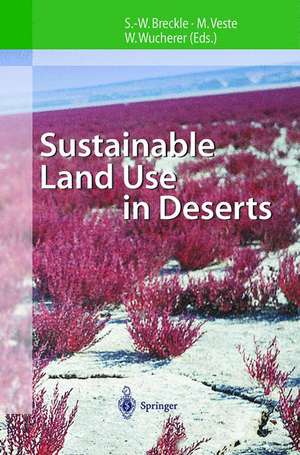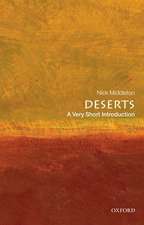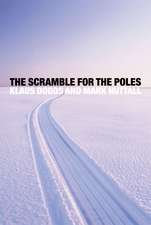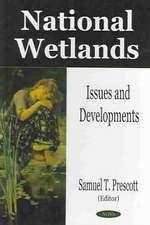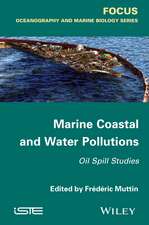Sustainable Land Use in Deserts
Editat de Siegmar-W. Breckle, Maik Veste, Walter Wuchereren Limba Engleză Hardback – 4 dec 2000
| Toate formatele și edițiile | Preț | Express |
|---|---|---|
| Paperback (1) | 1230.66 lei 6-8 săpt. | |
| Springer Berlin, Heidelberg – 12 oct 2011 | 1230.66 lei 6-8 săpt. | |
| Hardback (1) | 1232.26 lei 6-8 săpt. | |
| Springer Berlin, Heidelberg – 4 dec 2000 | 1232.26 lei 6-8 săpt. |
Preț: 1232.26 lei
Preț vechi: 1502.76 lei
-18% Nou
Puncte Express: 1848
Preț estimativ în valută:
235.80€ • 243.26$ • 196.77£
235.80€ • 243.26$ • 196.77£
Carte tipărită la comandă
Livrare economică 27 martie-10 aprilie
Preluare comenzi: 021 569.72.76
Specificații
ISBN-13: 9783540677628
ISBN-10: 3540677623
Pagini: 492
Ilustrații: XXIV, 465 p. 16 illus. in color.
Dimensiuni: 155 x 235 x 32 mm
Greutate: 0.86 kg
Ediția:2001
Editura: Springer Berlin, Heidelberg
Colecția Springer
Locul publicării:Berlin, Heidelberg, Germany
ISBN-10: 3540677623
Pagini: 492
Ilustrații: XXIV, 465 p. 16 illus. in color.
Dimensiuni: 155 x 235 x 32 mm
Greutate: 0.86 kg
Ediția:2001
Editura: Springer Berlin, Heidelberg
Colecția Springer
Locul publicării:Berlin, Heidelberg, Germany
Public țintă
ResearchCuprins
Deserts, Land Use and Desertification.- River Diversion, Irrigation, Salinization, Desertification — an Inevitable Succession.- I: The Aral Sea Crisis.- The Aral Sea Crisis Region.- Flora of the Dry Seafloor of the Aral Sea.- Vegetation Dynamics on the Dry Seafloor of the Aral Sea.- Methods of Conservation and Restoration of Vegetation Cover on the Aral Sea Coast.- Vegetation Dynamics on the Syrdarya Delta and Modern Land Use.- Ecological Basis for Botanical Diversity Conservation within the Amudarya and Syrdarya River Deltas.- The Tugai Forests of Floodplain of the Amudarya River: Ecology, Dynamics and Their Conservation.- Soil Crusts in the Amudarya River Delta: Properties and Formation.- Irrigation and Land Degradation in the Aral Sea Basin.- Ecology of the Aqueous Medium in the Area Surrounding the Aral Sea.- Potable Water: Research into Seasonal Changes and Conditions in the Aral Sea Region.- II: Salt Stress.- Halophytes on the Dry Sea Floor of the Aral Sea.- Halophytes: Structure and Adaptation.- Environmental State and an Analysis of Phytogenetic Resources of Halophytic Plants for Rehabilitation and Livestock Feeding in Arid and Sandy Deserts of Uzbekistan.- Salinity: A Major Enemy of Sustainable Agriculture.- III: Impact of Grazing.- Remarkable Differences in Desertification Processes in the Northern and Southern Richtersveld (Northern Namaqualand, Republic of South Africa).- Colour Plates.- How Grazing Turns Rare Seedling Recruitment Events to Non-Events in Arid Environments.- Vegetation Degradation in Northeastern Jordan.- Impact of Grazing on the Vegetation of South Sinai, Egypt.- Arid Rangeland Management Supported by Dynamic Spatially Explicit Simulation Models.- IV: Desertification Processes and Monitoring.- Remote Sensing of Surface Properties. The Keyto Land Degradation and Desertification Assessments.- Evaluation of Potential Land Use Sites in Dry Areas of Burkina Faso with the Help of Remote Sensing.- Degradation of the Vegetation in the Central Kyzylkum Desert (Uzbekistan).- Modern Geomorphological Processes on the Kazakhstanian Coast of the Caspian Sea and Problems of Desertification.- Anthropogenic Transformation of Desert Ecosystems in Mongolia.- Assessment of the Modern State of Sand—Desert Vegetation in Kazakhstan.- V: Reclamation.- Water-Harvesting Efficiency in Arid and Semiarid Areas.- The Effects of Landscape Structure on Primary Productivity in Source—Sink Systems.- Sedimentary Environments in the Desiccated Aral Sea Floor: Vegetation Recovery and Prospects for Reclamation.- Seeding Experiments on the Dry Aral Sea Floor for Phytomelioration.- Rehabilitation of Areas of Irrigation Now Derelicted Because of Strong Salinization in Ecologically Critical Zones of Priaralia.- Desert Soil Recultivation and Monitoring of (Phyto-) Toxicity: Pilot Project in Three Phases Lasting for 4 Years.- Contributions to a Sustainable Management of the Indigenous Vegetation in the Foreland of Cele Oasis — A Project Report from the Taklamakan Desert.- The Control of Drift Sand on the Southern Fringe of the Taklamakan Desert — an Example from the Cele-Oasis.- The Role of Biological Soil Crusts on Desert Sand Dunes in the Northwestern Negev, Israel.- Restoration of Disturbed Areas in the Mediterranean — a Case Study in a Limestone Quarry.- Indigenous Agroforestry for Sustainable Development of the Area around Lake Nasser, Egypt.- Ziziphus — a Multipurpose Fruit Tree for Arid Regions.- Root Morphology of Wheat Genotypes Grown in Residual Moisture.- Field Studies in Solar Photocatalysis for Detoxification of OrganicChemicals in Waters and Effluents.- VI: National Programs.- Activity of the Consulting Centre to Combat Desertification in Turkmenistan.- Desertification in China and Its Control.- Environmental Problems of the Southern Region of Kazakhstan.- National Strategy and Action Plan to Combat Desertification in Kazakstan.- VII: Social and Economic Aspects.- Economic-Demographic Strategies and Desertification: Interactions in Low-Income Countries.- Final Remarks.
Textul de pe ultima copertă
Changing desert areas for land use implies a lot of ecological problems. These and related ones are dealt with in this book covering various interdisciplinary and international aspects. Large areas in arid and semi-arid regions are already polluted in various ways. One of the biggest problems is the anthropogenic salinization by inadequate means of agriculture and irrigation. Additionally, most arid areas in the world are dramatically overgrazed. Methods and practices of a sustainable land use in deserts are urgently needed in many arid regions. This book gives a broad survey on some of the affected regions of the world as well as some case studies from elsewhere (Aral Sea, Negev desert, Namib desert etc.). Thus, basic and applied sciences are brought together. Water management in deserts, grazing systems or reclamation of desertified areas are among the topics of this book, as well as social and economic aspects.
Caracteristici
State-of-the-art of the ecological research on all problems of land use in various deserts Includes supplementary material: sn.pub/extras
